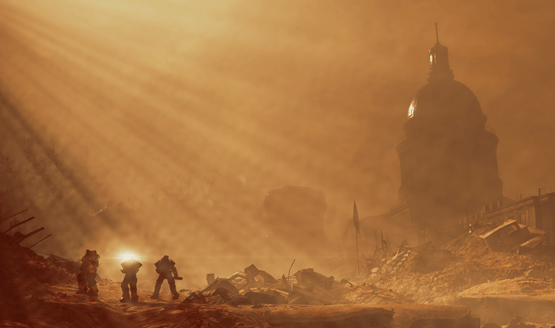Fallout 76 has a lot going on. That was pretty evident last month with my hands-on preview, but during this week’s B.E.T.A., I’ve been able to dive even further into the virtual Appalachia. I’ve tried everything under the sun when it comes to exploring: solo and group adventures, scavenging for loot, crafting, bartering, and more. When taking those into account, this feels just like any other Fallout title, which I mentioned a few weeks ago. But I never got a solid grasp on the game’s story missions, which are told mostly through robots and holotape recordings. While this didn’t seem like a huge deal when Bethesda broke down the concept, I’ve changed my mind a bit.
You see, the first few missions are given via recordings of the Overseer of Vault 76, who’s been exploring the world one step ahead of you. Through these tapes, she explains how to look for supplies, craft items, cook food, boil water, and gives general directions through the world. It serves the same purpose as any other tutorial chain, and honestly, works similarly to other Fallout intros minus the dialogue choices.
https://www.youtube.com/watch?v=tOUIBZrzsfM&t
But these missions feel much different than those older intros. Conversing with a non-player character is a very direct approach to game design, and it gives a player agency in the world around them. Choices appear to matter, whether the developer programmed for the choice or not. Removing that dialogue also removes that same agency. Holotapes and recordings, while serving the same mechanical function, don’t provoke the same emotional response. They’re very passive, a “tune out and you miss it” kind of design.
In many other games, these sorts of recordings are played as optional cues tied to collectibles. They’re meant to be something you pick up and listen to as you move on with the “real” story. In some adventures, the playback stops if you enter combat or leave the collectible menu. Even when the audio logs keep rolling, they can be drowned out by noisy atmospheres or busy scenarios. It’s easy for them to lose a player’s focus, because it requires a specific type of multitasking. Players must be attentive to both the game and recording at the same time, else they simply stand in place and wait for the tape to finish. We’ve seen it with the backpack collectible monologues in Marvel’s Spider-Man, the patient interview tapes in Batman Arkham Asylum, and even the audio diaries in BioShock. While fascinating, they’re very much a “side thing,” and after years of collectibles, some players are tired of this.
I don’t want to be tired of this. I wish I could change the slow crawl of boredom that takes hold while I stand in place in Fallout 76, hoping beyond hope that the Overseer gets her point across before a mole rat interrupts my focus. It’s undeniable though: listening to a tape isn’t as stimulating as talking to something. Voice recordings do a fantastic job of building the world and conveying info (when players can actively listen to them), but they don’t get the point across as well as a normal conversation.
https://www.youtube.com/watch?v=kL37bdn6X2g
The game’s many handwritten notes are the same way. Scattered throughout Appalachia, these short memorandums all use the same “handwriting” font and provide some context to the environment. But they don’t always give the player anything to do or see in the world around them; they’re just there to flesh out a hidden story. I can’t help but contrast this with my recent excursions in Red Dead Redemption 2, where I found half a dead body hanging from train tracks. A cryptic, blood-soaked note and map laid nearby, and I immediately wanted to drop everything to catch the murderer. It’s such a simple item, yet the mystery consumes me. That map isn’t there to simply flesh out the world—it’s giving me agency, and letting me find my own story.
A few simple lines in a note don’t elicit that same feeling, nor do voice recordings. Sure they tell a story, but in a game as expansive as Fallout 76, does that sort of passive backstory matter? Is it interesting to simply be told a story? Players are looking for a tale they can be a part of, one they can help write. They want to interact. Fallout 76 succeeds as a meticulously built, lived-in world, but treats players as museum attendees in a land they’d rather intimately shape. That’s fine in an experience like What Remains of Edith Finch or Gone Home, but doesn’t fly as well in an immersive, multiplayer RPG-turned-survival game.
I must stress that I’ve only played around 7 hours of Fallout 76, most of it being the same sections repeated. My opinions on this could definitely change once I dig further into the main storyline—and by all means, please stay tuned for PlayStation LifeStyle’s full review. But it’s hard to see Fallout 76‘s appeal beyond a series of multiplayer explorations. These tapes and notes aren’t hooking me. Appalachia, in all its post-apocalyptic glory, is so wild and wonderful that I sincerely hope I find more of a reason to stay. As for now, though, Fallout 76‘s storytelling techniques aren’t that reason.




